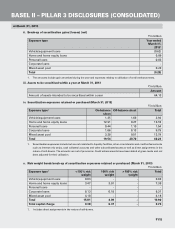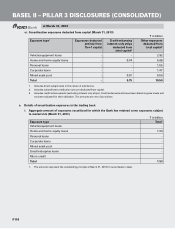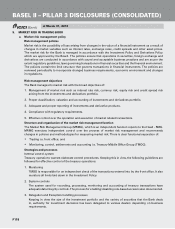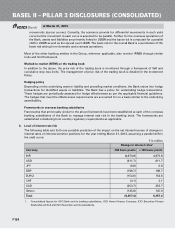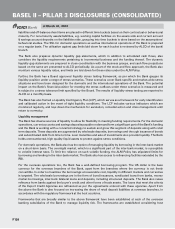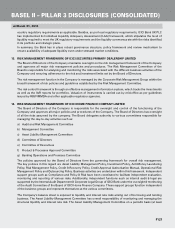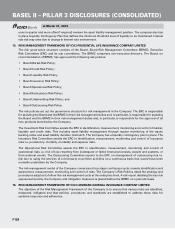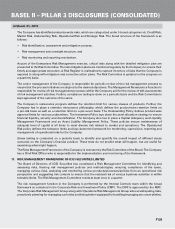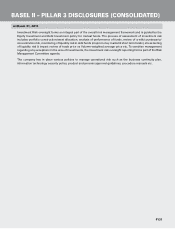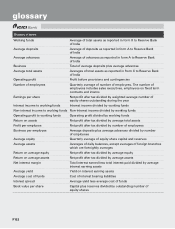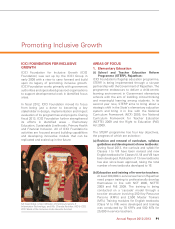ICICI Bank 2013 Annual Report Download - page 201
Download and view the complete annual report
Please find page 201 of the 2013 ICICI Bank annual report below. You can navigate through the pages in the report by either clicking on the pages listed below, or by using the keyword search tool below to find specific information within the annual report.
F123
rate risk on the basis of its expectations of future interest rates. Based on the guidance, ALMG manages the
IRRBB with the help of various tools i.e. gap analysis, earning at risk (EaR), duration of equity (DoE), stress
testing for basis risk etc. These tools are as follows:
• Gap analysis: The interest rate gap or mismatch risk is measured by calculating gaps over different
time intervals at a given date for domestic and overseas operations. Gap analysis measures mismatches
between rate sensitive liabilities (RSL) and rate sensitive assets (RSA) (including off-balance sheet
positions). The report is prepared by grouping rate sensitive liabilities, assets and off-balance sheet
positions into time buckets according to residual maturity or next re-pricing period, whichever is earlier.
For non-maturity assets/liabilities (for instance, working capital facilities on the assets side and current and
savings account deposits on the liabilities side) grouping into time buckets is done based on behavioral
studies or by making certain assumptions. The difference between RSA and RSL for each time bucket
signifies the gap in that time bucket. The direction of the gap indicates whether net interest income is
positively or negatively impacted by a change in the direction of interest rates and the extent of the gap
approximates the change in net interest income for that given interest rate shift. The ALM Policy of the
Bank stipulates bucket-wise limits on Rupees interest rate gaps for the domestic operations of the Bank,
linked to the networth of the Bank.
• EaR: From an EaR perspective, the gap reports indicate whether the Bank is in a position to benefit
from rising interest rates by having a positive gap (RSA > RSL) or whether it is in a position to benefit
from declining interest rates by a negative gap (RSL > RSA). The Bank monitors the EaR with respect to
net interest income (NII) based on a 100 basis points adverse change in the level of interest rates. The
magnitude of the impact over a one year period, as a percentage of the NII of the previous four quarters
gives a fair measure of the earnings risk that the Bank is exposed to. The EaR computations include the
banking book as well as the trading book.
For some of the products, Bank provides its depositors and borrowers an option to terminate the deposit/
loan pre-maturely. These products may or may not provide for a penalty for premature termination. In
case of pre-mature terminations, the Bank faces a risk of re-pricing of the assets/liabilities at the current
rates and the resultant impact on the NII (adjusted for the penalty), over and above the impact as estimated
through EAR. However, the re-pricing/re-investment risk is partly mitigated on account of the premature
termination option in wholesale term deposits and term loans being captured through the behavioral
studies implemented in the interest rate gap statement as mentioned in the earlier paragraphs
• DoE: Change in the interest rates also have a long-term impact on the market value of equity of the
Bank, as the economic value of the Bank’s assets, liabilities and off-balance sheet positions is impacted.
Duration is a measure of interest rate sensitivity of assets, liabilities and also equity. It may be defined as
the percentage change in the market value of an asset or liability (or equity) for a given change in interest
rates. Thus DoE is a measure of change in the market value of equity of a firm due to the identified
change in the interest rates. The Bank uses DoE as a part of framework to manage IRRBB for its domestic
and overseas operations and DoE is computed for the overall Bank and banking book separately. The
ALM Policy stipulates a limit on the overall DoE of the Bank and the banking book separately in order to
monitor and manage IRRBB. The utilisation against these limits is computed for appropriate interest rate
movements and monitored periodically.
• Stress test for basis risk: The assets and liabilities on the balance sheet are priced based on multiple
benchmarks and when interest rates fluctuate, all these different yield curves may not necessarily
move in tandem exposing the balance sheet to basis risk. Therefore, over and above the EaR, the Bank
measures the impact of differential movement in interest rates across benchmark curves. For the domestic
operations various scenarios of interest rate movements (across various benchmark yield curves) are
identified and the worst-case impact is measured as a percentage of the aggregate of Tier-1 and Tier-2
capital. These scenarios take into account the magnitude as well as the timing of various interest rate
BASEL II – PILLAR 3 DISCLOSURES (CONSOLIDATED)
at March 31, 2013




